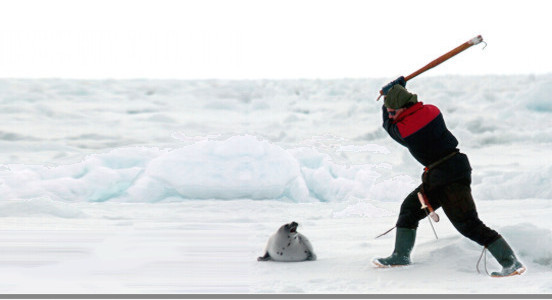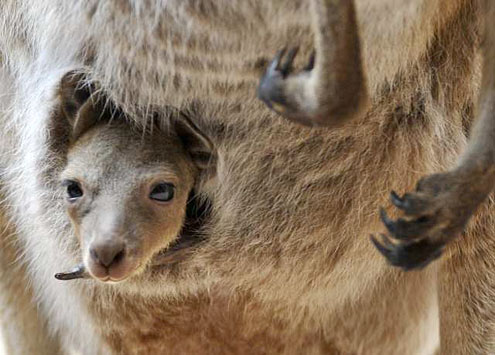 Canadian sealer about to club a seal pup. © IFAW
Canadian sealer about to club a seal pup. © IFAW
harpseals.org
On 5th May 2009, Members of the European Parliament voted in favour of adopting strict conditions for the placing on the market of seal products in the European Union.
The way kangaroo joeys are slaughtered by 'professionals' is comparable to that still inflicted on Canadian fur seal pups. Australian poaching of its wildlife places it culturally backward in the 19th Century, when native animals were vermin and 'the 'bush' regarded as wasteland.
Australian society needs to wake up to what is happening outback and call for immediately bans on wildlife killing including banning the State-sanctioned industrial poaching of kangaroos. The so-called kangaroo 'industry' is no different to the fur seal 'industry' or the whaling 'industry'. They are each shameful practices of immoral brutality. Take a walk through Albany's old Whaling Station (now a musem) in Western Australia to see what we did to whales...not that long ago.
 Perhaps this photo should go on all the kangaroo meat export packaging and on The Moscow Times newspaper! Both mother and joey are what the Russians are eating!
Perhaps this photo should go on all the kangaroo meat export packaging and on The Moscow Times newspaper! Both mother and joey are what the Russians are eating!
Australia's 'National Code of Practice for the Humane Shooting of Kangaroos and Wallabies for Commercial Purposes' at Section 4. EUTHANASING INJURED KANGAROOS AND WALLABIES permits an injured kangaroo or wallaby...if " shot to either the brain or heart is impractical or unsafe (such as when the animal is moving but not able to stand), [then] a heavy blow to the base of the skull with sufficient force to destroy the brain (see Schedule 2) is permissible."
...and the Code prescribes as follows:
"Small furless pouch young (fits within the palm of the hand):
"Single forceful blow to the base of the skull sufficient to destroy the functional capacity of the brain. OR Stunning, immediately followed by decapitation by rapidly severing the head from the body with a sharp blade."
All furred pouch young: "Single forceful blow to the base of the skull sufficient to destroy the functional capacity of the brain."
Young at foot: "Single shot to the brain or heart where it can be delivered accurately and in safety using the firearms and ammunition."
And this when the Code is actually being followed. But who polices this? Who is turning a blind eye? Queensland Premier Anna Bligh is even promoting it - flying to Russia to boost the meat sales, so that more kangaroos can be slaughtered!
The above practice is comparable to clubbing fur seal pups by Canadian sealers! Australia should immediately ban poaching of kangaroos and Australian wildlife in national legislation and should apply similar conditions on the kangaroo meat export and hide export markets, starting with Russia!
European Parliament decision to restrict seal fur trade
The following is the excerpt from the European Parliament decision to restrict seal fur trade:
"The placing on the market of seal products should not be allowed say MEPs. It is permitted only where the seal products result from hunts traditionally conducted by Inuit and other indigenous communities. Otherwise the import is permitted where it is of an occasional nature and consists exclusively of goods for the personal use of the travellers. Furthermore it is allowed to place on the market products that result from by-products of hunting [and] conducted for the purpose of sustainable management of marine resources on a non-profit basis.
Conditions for placing on the market
The placing on the market of seal products shall be allowed only where the seal products result from hunts traditionally conducted by Inuit and other indigenous communities and which contribute to their subsistence. These conditions shall apply at the time or point of import for imported products.
The legislative report which has been agreed with the Council in first-reading has been drawn up by Diana WALLIS (ALDE, UK). The legislative resolution was adopted with 550 votes in favour, 49 against and 41 abstentions.
The Regulation establishes harmonised rules concerning the placing on the market of seal products. It is therefore without prejudice to other Community or national rules regulating the hunting of seals.
By way of derogation from the above:
(a) the import of seal products shall also be allowed where it is of an occasional nature and consists exclusively of goods for the personal use of the travellers or their families. The nature and quantity of such goods may not be such as to indicate that they are being imported for commercial reasons;
(b) the placing on the market shall also be allowed for seal products that result from by-products of hunting that is regulated under national law and conducted for the sole purpose of sustainable management of marine resources. Such placing on the market shall only be allowed on a non-profit basis. The nature and quantity of such products shall not be such as to indicate that they are being placed on the market for commercial reasons.
Definition of (indigenous) Inuit
"Inuit" means indigenous members of the Inuit homeland – i.e. those arctic and subarctic areas where, presently or traditionally, Inuit have Aboriginal rights and interests – recognized by Inuit as being members of their people and includes Inupiat, Yupik (Alaska), Inuit, Inuvialuit (Canada), Kalaallit (Greenland) and Yupik (Russia)
Penalties
Member States will lay down the rules on penalties applicable to infringements of this Regulation and shall take all measures necessary to ensure that they are implemented. The penalties provided for shall be effective, proportionate and dissuasive.
Omega-3
MEPs point out that the existence of those diverse legal requirements may further discourage consumers from buying products not made from seals, but which may not be easily distinguishable from similar goods made from seals, or products which may include elements or ingredients obtained from seals without this being clearly recognisable, such as furs, Omega-3 capsules and oils and leather goods.
Entry into force
This Regulation shall enter into force on the 20th day following that of its publication in the Official Journal of the European Union. The article on conditions for placing on the market enters into force nine months from the date of entry into force of this Regulation.
Debate on subject held 4 May 2009
Diana Wallis (ALDE, UK) rapporteur said: "Seals are very beautiful marine animals – in fact, I have realised during this process that they have great PR – but to some they are the rats of the sea. That is how they are perceived by many fishermen: an adult seal gets through an enormous amount of fish on a daily basis. Therefore, there will remain the need for seals to be hunted to ensure the sustainability of fisheries in some area."
But what we have not done here is to regulate hunting. If people in any of our Member States wish to hunt, they can still continue to hunt. What they cannot do is take commercial gain from the results of that hunt. But it should be the case that the results of the hunt can be used, and I hope particularly that those parts of seals that can be used by the medical community will be able to be used."
Malcolm Harbour (EPP-ED, UK) said: "I think this is a call for action. What people have indicated so far is that this is the beginning of a process and not an end. The issue is the inhumane way in which seals are being killed and the inability of the professional hunters to deal with it. I think the Canadian Government has to reflect on that as well. There are plenty of review clauses built in here to ensure this works. I think the exemptions are well balanced because firstly they reflect the importance of supporting traditional hunting in communities."
Arlene McCarthy (PES, UK) said: "The USA has had a ban for many years, Mexico has banned the trade; in Europe we already have national bans in Belgium, the Netherlands, Luxembourg and Italy; Germany and the UK are considering ways to ban the trade; bans are now in place in Russia; Hong Kong is planning a ban. This is a political issue that now has it time. After a 40 year campaign against the trade, Europe has the chance to introduce a ban in all 27 states. This year 50 000 seals have been slaughtered that Canadians hunt compared to 220 000 last year. That means that we as citizens have now the opportunity to ban this cruel trade. I know that this will be applauded by the citizens of Europe."
Caroline Lucas (Greens/EFA, UK) said: "Today, nearly one million seals are slaughtered annually in commercial seal kills around the world, and when we vote on this package tomorrow, we will be helping to end one of the most vile examples of animal cruelty."
Avril Doyle (EPP-ED, IE) said: "This has been a difficult debate, often emotional, with the heart ruling the head on many occasions. Great progress has been made in the survival and quality of life of cardiac patients by using the aortic, pulmonary and pericardial tissue of harp seals, the assumption being that they are sustainably hunted or killed and not in a cruel way. I would like assurances on ongoing medical research and bioprosthetic use of products from seals in the context of the compromise".
Background
According to EC proposal, Denmark and Italy are by far the two largest importers of raw fur skin from seal for further processing/sales on the Community market, and will thus also be affected by such regulation. Denmark imports the raw fur skins directly coming from Canada and Greenland (that are not categorised as goods in transit), while Italy imports the raw fur skins from Russia, Finland and the UK (Scotland). Greece also has a noticeable trade in raw skins originating in the two latter range states."
The Kangaroo Industry Association of Australia (KIAA) tries to justify the industrial scale slaughter of kangaroos and their young by claiming it's hygienic standards are monitored. Its wesbite boasts 1,076 inspections of 'kangaroo harvesting vehicles' and 621 inspections of 'kangaroo carcass holding chillers' by the NSW meat hygiene authority, Safe Food NSW. Of course if the meat was received contaminated by the abattoirs, then sales and a shooter's reputation would drop off fast.
What is not monitored is the field shooting. Somehow the KIAA believes shooting a kangaroo in the neck is close enough to shooting it in the head. "The vast majority of non-head shots (reported by RSPCA as body shots) were high in the neck at the base of the skull and it appears the result of harvesters deliberately targeting this site." Of course the so-called 'industry' will claim "99.8% of kangaroos are shot in the head". But where are the independent DECC zoological reports verifying the poaching practice including treatment of young is humane as is claimed?
Queensland Premier Anna Bligh should refund the Queensland taxpayer the cost of her junket to Russia last month flogging Kangaroo meat exports.

Add comment